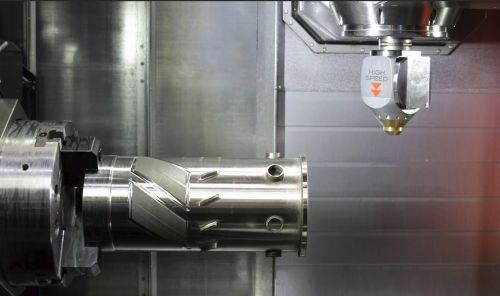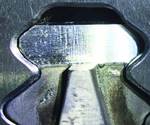Two Heads Better Than One in Hybrid Additive/Subtractive Machine
New Mazak Integrex capable of additive manufacturing includes heads for both high speed and high precision metal deposition. “Natural extension of multitasking,” the company says.
In “subtractive” manufacturing (that is, machining), we take it for granted that an efficient process might consist of both a high-speed roughing step and a high-precision finishing step. Why shouldn’t additive manufacturing have these same two options?
At the JIMTOF show concluding this week in Japan, Mazak introduced a new hybrid additive/subtractive multitasking machine, the Integrex i-400AM, which features heads for both high speed and high precision laser cladding for direct metal deposition.

The new machine extends the definition of multitasking, including turning, milling, drilling, additive manufacturing and laser marking in the same machine.
Collaboratively developed with Hybrid Manufacturing Technologies (a company we reported on here), the dual laser cladding heads (or additive manufacturing nozzles) provide options for either rapid and coarse metal deposition or slower deposition with fine precision. The two heads complement one another—and provide for efficient processing—in much the same way that roughing and finishing tools work together in machining.
The cladding heads reside in the machine’s tool magazine and can be called up as needed. Mazak says it views metal deposition as a natural extension of multitasking—that is, an opportunity to perform more steps and add still more value within a single CNC cycle.
The laser cladding can be used to build near-net-shape 3D forms. Thus, the machine is a potentially attractive choice for small-lot production of parts made from difficult-to-machine metals, because it provides the option for some part features to be grown instead of being generated entirely through machining.
The laser cladding can also be used to coat chosen sections of the part with metal, allowing the machine to repair worn or damaged components such as turbine blades. This cladding could even be used to join different metals in the same cycle.
The full five-axis milling and turning machine tool features machining capabilities comparable to other models in its family. The milling spindle feeds through a B-axis range of –30/+210 degrees, while the spindle that holds the part for turning also permits full C-axis contouring. The tailstock too is fully programmable. Learn more about the Integrex i-400AM here.

Combining laser cladding and machining in the same cycle means that surfaces can be added to parts or features can be grown onto parts within the same cycle that also performs turning or five-axis milling.
Related Content
-
UMaine’s FoF 1.0 Large-Scale 3D Printer Shatters Former Guinness World Record for Additive Manufacturing
The large-scale thermoplastic polymer printer offers new opportunities for eco-friendly and cost-effective manufacturing for numerous industries, including national security, affordable housing, bridge construction, ocean and wind energy technologies, and maritime vessel fabrication.
-
JuggerBot 3D Awarded $4 Million by Air Force to Develop Large Format Hybrid Additive System
The project focuses on advancing the ability to print a thermoset composite material that can transform the way an aircraft structure is designed, fabricated and sustained for limited-life aircraft.
-
Hybrid Additive Manufacturing Improves Debarking Knife Tip Strength and Production Efficiency
Nicholson Manufacturing chose the Mastercam APlus specialized add-on to unlock hybrid manufacturing for making its debarker knife tips, enabling it to add durable layers to the wear surfaces of the tips to make them more resilient while also making the production process more efficient.














